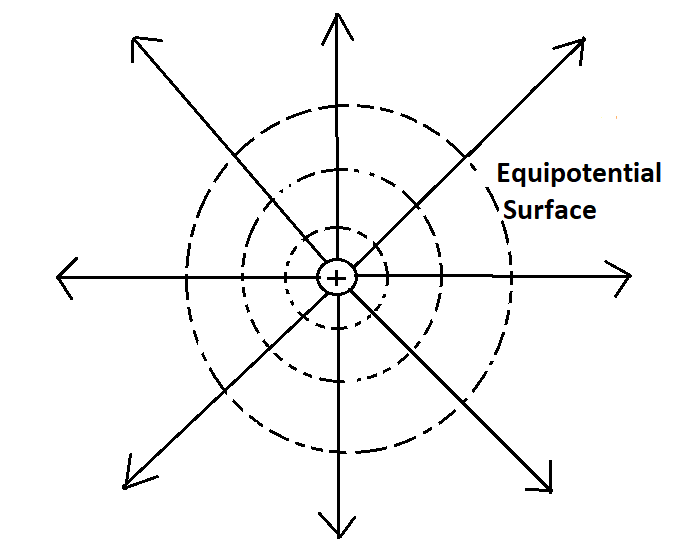
Write two properties of equipotential surfaces. Depict equipotential surfaces due to an isolated point charge. Why do the equipotential surfaces get closer as the distance between the equipotential surface and the source charge decreases?
Answer
513k+ views
1 likes
Hint: Equipotential surfaces are surfaces with equal potential throughout their surface. For a point charge these equipotential surfaces appear around as concentric spherical shells.
Complete step by step answer:
An equipotential surface is a surface over which potential is the same at every point.
The figure given below depicts the equipotential surfaces formed due to an isolated point charge +q and Electric field coming out of it.

Properties of equipotential surfaces are:
1. The direction of electric field is always perpendicular to the equipotential surface coming from a region of high potential to a region of low potential.
2. No two equipotential surfaces can intersect each other because at the point of intersection there would be two different values of potential which is not possible.
The equipotential surfaces are close together as the distance between the surface and source charge increases because of a strong electric field near the source charge.
We know that the relation between the electric field and the potential is given by:
Since for equipotential surfaces
We have
Which depicts that as the distance r decreases the Electric field strength increases and therefore the equipotential surfaces come close together near the source charge.
Note: Students should note that the work done in moving a unit charge over an equipotential surface is zero.
Complete step by step answer:
An equipotential surface is a surface over which potential is the same at every point.
The figure given below depicts the equipotential surfaces formed due to an isolated point charge +q and Electric field coming out of it.

Properties of equipotential surfaces are:
1. The direction of electric field is always perpendicular to the equipotential surface coming from a region of high potential to a region of low potential.
2. No two equipotential surfaces can intersect each other because at the point of intersection there would be two different values of potential which is not possible.
The equipotential surfaces are close together as the distance between the surface and source charge increases because of a strong electric field near the source charge.
We know that the relation between the electric field and the potential is given by:
Since for equipotential surfaces
We have
Which depicts that as the distance r decreases the Electric field strength increases and therefore the equipotential surfaces come close together near the source charge.
Note: Students should note that the work done in moving a unit charge over an equipotential surface is zero.
Latest Vedantu courses for you
Grade 8 | CBSE | SCHOOL | English
Vedantu 8 CBSE Pro Course - (2025-26)
School Full course for CBSE students
₹45,300 per year
Recently Updated Pages
Master Class 9 General Knowledge: Engaging Questions & Answers for Success

Master Class 9 English: Engaging Questions & Answers for Success

Master Class 9 Science: Engaging Questions & Answers for Success

Master Class 9 Social Science: Engaging Questions & Answers for Success

Master Class 9 Maths: Engaging Questions & Answers for Success

Class 9 Question and Answer - Your Ultimate Solutions Guide

Trending doubts
Draw ray diagrams each showing i myopic eye and ii class 12 physics CBSE

Why do the transition elements have higher enthalpies class 12 chemistry CBSE

What are the advantages of parallel combination over class 12 physics CBSE

What are the causes of overloading class 12 physics CBSE

How do you convert from joules to electron volts class 12 physics CBSE

There is hypertension due to smoking Give scientific class 12 biology CBSE




